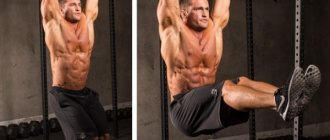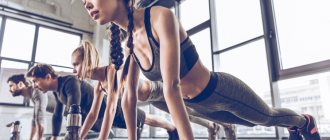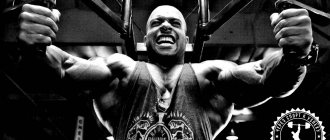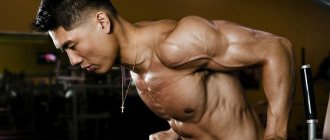Every novice athlete, sooner or later, wonders how to create a training program on their own. To create a competent training program, it is enough to follow simple rules, which will not be difficult to master. It will take much more time to use these rules to choose a truly effective training program that is suitable for you. Since there is no universal program for all occasions, you will have to take time to try different approaches and observe how your body reacts to them.
If we talk in general terms about what the process of strength training is, then we can say that it is a series of constant destruction and restoration. In the process of training, whether training at home or in the gym, we damage muscle fibers. When we sleep, muscle fibers repair and thicken. In this way, our body prepares for less muscle damage next time. In order for muscles to have the opportunity to recover, we must eat properly, providing the body with all the necessary elements.
So, the right training program should provide a good load on the body and sufficient time for muscle recovery after this load. We will achieve the first by doing strength exercises, while the second is achieved by rest after training and proper nutrition. As we can see, a truly effective workout is not just a set of exercises performed in the gym. This is also discipline and adherence to a certain regime, since truly noticeable results can only be achieved by training on an ongoing basis. You will have to change your schedule, build regular workouts into it, rest well, and monitor your diet and diet. Only in this case, after a long time, the result will be noticeable - that very athletic body that you will want not only to show to others, but also to admire it yourself in front of the mirror!
Selection of exercises
First of all, you need to figure out the load, which exercises should be performed in the gym. Indeed, there are a great many exercises: these are ordinary exercises with dumbbells and barbells, which can be performed at home, and many different exercise machines that help us perform exercises in the gym more concentratedly and safely. We will not go into details and consider any specific ones. Once you start exercising, you will quickly acquire your favorite machines and exercises. A much more important point is not exactly what exercises you perform, but how you complete them, how exactly the exercises are distributed across training days, what needs to be trained in one workout and what in another, which muscles to work at the beginning and which at the end of the workout.
There are three basic rules that can be followed when distributing exercises between training days. Basically, these rules are used to fill the training program with exercises.
Top bottom
The legs are the largest muscle group in our body. Therefore, there is an opinion that these muscles should generally be given a separate training day. This is also facilitated by the fact that the hamstrings and quadriceps belong to different push-pull groups, which makes it possible to train them simultaneously without any problems. Among other things, there is also an opinion that muscles such as biceps and triceps do not need to be trained separately at all, since they already receive enough load when performing exercises on the chest and back. Guided by these rules, we can conditionally divide our body into the upper part: back, chest and lower part - legs, and train these parts alternately. Although it is generally accepted that this scheme is more suitable for beginners to train two days a week when moving from a fullbody system to a split system, the same scheme can be used by already experienced athletes in an intensive four-day training program. An example would be the following distribution of muscle groups by training day:
- Chest, back, shoulders
- Legs, abs
Pull - Push, synergists
The thing is that our muscle groups can be divided into pulling and pushing. Pulling groups include: back, biceps (biceps brachii), biceps femoris (biceps femoris). Pushing muscles include: chest, deltoids, triceps (triceps brachii), quadriceps (quadriceps femoris), calves. The essence of the rule is not to train muscles from the same group in one workout. This can be explained using the example of the back and biceps. These muscles belong to the same group “Pulling” and the biceps are also involved in many back exercises. It turns out that if you first perform an exercise on the back, and after that an exercise on the biceps, it will be ineffective, since the biceps have already worked to help the back. Performing an exercise on the biceps, and then an exercise on the back, is also not the best option, since the biceps, already tired after its exercise, will not allow you to completely perform the exercise on the back, because it will fail first. To prevent this from happening, it is customary not to include muscles from one group in one workout. As an example, we can consider a three-day training program with the following distribution of muscle groups by training days:
- Chest, biceps
- Back, triceps
- Legs, shoulders
Antagonists, bend - unbend
In this case, the muscle groups should be divided into flexor and extensor muscles. The point here is that our muscles often “walk in pairs” and perform opposite movements when working. Thus, some bend the joints, others straighten them. These pairs of muscles are called antagonists. An example is the biceps, which is responsible for flexing the arm at the elbow joint, and the triceps, which is responsible for extending the arm. The same situation is in the case of the legs: the biceps of the thigh flexes, and the quadriceps extends the leg at the knee. When you perform an exercise on a certain muscle, the opposite antagonist rests or is in slight static tension. Thus, following this rule, muscle groups can be distributed among training days according to the principle of working them in pairs, for example:
- Chest, back
- Legs, shoulders
- Hands, abs
All at once or all separately
Undoubtedly, the easiest way is to either train everything at once in one workout or train each group separately in a separate workout. The first is more suitable for completely beginner athletes, since they usually do not have much muscle mass and do not require much recovery time. Therefore, a three-day training program, with a full workout of the entire body on each training day, would be quite normal.
In the second case, we are talking about training programs for already professional athletes. On the contrary, they have large muscle mass and in order to work out their muscles well, they need to try hard. Therefore, it is not possible to train muscles together. Moreover, such a program requires a lot of free time, which in most cases those who do not do this professionally do not have.
Sequence of exercises
The effectiveness of the training process also depends on the order in which the exercises are performed during training. The muscles of our body vary in volume. The effort that needs to be spent on working it depends on the volume of the muscle; larger muscles need to be loaded more intensely. Also, the recovery time of the muscle depends on the volume of the muscle, so small muscles recover faster. Large muscles include the chest, back, and legs. Small muscles include shoulders, biceps, triceps, calves. There is a rule that recommends starting your workout with exercises for large muscles, and ending it with training smaller muscles. The logic here is that the small muscles trained at the beginning get tired and prevent the large muscles from being fully trained at the end. You should also take this rule into account when planning training days for the whole week, training according to the antagonist scheme or training everything separately. We train large muscles at the beginning of the week, and small muscles at the end.
How to do physical exercise correctly
Council of the Ministry of Health and Social Development of Russia – www.takzdorovo.ru
A journey of a thousand miles begins with the first step... Chinese proverb.
In order for the effect of physical education to be lasting, you need to make it your way of life! You need to understand that there are no exercises, complexes, training methods and concepts that are ideal for everyone; in each specific case, these issues must be resolved individually, under the supervision of a sports doctor or exercise therapy doctor.
Here are the basic rules that must be followed regardless of the level of training of the student and the nature of the exercises performed.
Regularity. In order to feel the effect of physical education, sometimes a few sessions are enough, but for this effect to be lasting, you need to make such exercises your way of life. Properly performed physical exercise differs from drugs in that the more we use it, the more effective it is, it does not become addictive and there are no side effects. It is not necessary to exercise every day, 3-4 times a week is enough, but it needs to be done regularly: practice shows that the most difficult in this regard are the first 3 weeks of classes, after which you get used to this rhythm, and the lack of physical activity will seem unusual. Systematicity. The exercises that you perform must be strictly regulated, with a clear focus on solving your specific problems and achieving certain goals. Ideally, a training system should be developed by a specialist doctor, taking into account the characteristics of your body, choosing the type of exercise, as well as the volume and intensity of the load that is suitable for you. By exercising haphazardly, you run the risk of not only not achieving the desired effect, but even, on the contrary, harming your health.
Adequacy. Before you begin any exercise, you must realistically assess your strength. In order to know the objective state of your body, you need to consult with a qualified doctor and undergo certain diagnostic examinations. But, in any case, if the proposed exercise seems too complicated and you are not sure of the correctness of its implementation, it is better to abandon it or try a simplified version. If the load from an exercise, despite all the correctness of execution, seems excessive to you or causes pain, then you should also abandon it and choose something easier. In addition, you should avoid doing any exercise if you have a fever above 37°C the day before.
Self-control. As noted earlier, it is best when your training is carried out under the supervision of a qualified sports physician, but one way or another, you yourself must be able to determine what shape you are in at the moment, as well as monitor your condition over time. The simplest and most effective way for such self-monitoring is to conduct an orthostatic test. Waking up in the morning, without getting out of bed, measure your pulse for 1 minute, then get up quite quickly, immediately measure your pulse for 10 seconds and multiply the resulting value by 6. Then compare the results. Normally, the pulse value in a lying position should differ from the pulse value immediately after you get up by no more than 12-24 beats per minute. By observing this indicator every day, you can evaluate how effective your training is. If the difference gradually decreases and then stabilizes at lower values than before starting training, then you are in good shape. If on some day you notice an increase in the indicator, then you need to give yourself a short break, and if this does not help, then reconsider the training system.
We will give examples of exercises that develop such important physical qualities as strength, endurance and flexibility, as well as recommendations for their correct implementation. Let us emphasize once again that the exercises we present are as universal as possible and affect the main muscle groups; however, they may not be suitable for some. Exercises to develop strength. Strength is the ability to overcome external resistance or counteract it through muscular effort. Exercises to develop strength can be using your own body weight, as well as with weights. It is very important not to interrupt your breathing while performing a strength exercise.
Pushups. This exercise strengthens the core muscles of the arms, upper back and chest. From the starting position “lying down”, flexion and extension of the arms are performed. If this exercise seems too difficult, you can simplify it by resting on your knees rather than your feet (especially for women). Try to keep your torso and legs in one line and avoid arching your back; to do this, focus your attention on working your abdominal muscles.
Torso bending with turns. This exercise strengthens the core muscles of the abdominals and lower back. From the starting position, lying on your back, legs suspended, bent at a right angle, feet crossed, arms behind the head, it is necessary to perform flexion - extension of the torso, alternately bringing the left elbow closer to the right knee and the right elbow to the left knee. If this exercise seems too difficult, then you can perform movements in the same direction, but with a smaller amplitude, or lift your torso in a straight line. Try to avoid excessive flexion in the thoracic spine.
Squats. This exercise strengthens the core muscles of the legs. From the initial standing position, legs slightly wider than shoulder-width apart, leg flexion and extension are performed. If this exercise seems too difficult, then you can place your legs a little wider or perform squats with a smaller amplitude (half squats). Try to keep your torso straight and do not lift your heels off the floor.
Exercises to develop endurance. Endurance is the ability to continue any work without reducing its effectiveness. For health purposes, it is recommended to develop endurance through training lasting at least 30-40 minutes, keeping the pulse within a certain interval (calculated individually, but the average values range from 120 to 150 beats per minute). This could be walking, jogging, swimming, cycling, exercise on an exercise bike, etc.
Exercises to develop flexibility. Flexibility is the ability of the musculoskeletal system to perform movements with a large amplitude. To develop flexibility, stretching exercises are used to stretch muscles, tendons, and ligaments. For greater effectiveness, it is better to perform fewer approaches, but several times a day. All stretching exercises are performed slowly and smoothly; the greatest stretching can be done during exhalation. Neck muscle strain. This exercise improves mobility in the cervical spine. From the starting position, standing, we place our right arm, bent at the elbow, behind our back, with our left hand we tilt our head to the left side until we feel a slight tension in the right side of the neck, then we change hands and perform the exercise in the other direction. Try to keep your back straight and avoid turning and tilting your head forward and backward.
Shoulder girdle muscle strain. This exercise improves the mobility of the shoulder blades and increases the range of motion in the arms. From the starting position, standing, we try to connect our hands behind our back, between the shoulder blades, left hand below, right hand above, then change hands. If it is impossible to achieve direct contact of hands, you can use improvised means (towel). Try to keep your back straight and avoid bending or bending your torso.
Stretching the muscles of the back and back of the legs. This exercise increases mobility in the lumbar and thoracic spine. From the starting position, sitting on the floor, we bend our torso forward, trying to reach our feet with our fingers. If this is not possible, then we focus on stretching the lower back.
Stretching the muscles of the front of the legs. This exercise increases the range of motion in your legs. From the starting position, standing, hold the support with your right hand at shoulder level, bend your left leg so as to grab your foot with your left hand, lower the knee of your left leg down until you feel a stretch along the front surface of the thigh. Try not to arch your back. Stretching the muscles of the inner surface of the legs. This exercise increases mobility in the hip joint. From the initial standing position, we move our right leg to the side and place it on a chair, then bend forward until a slight sensation of tension is felt on the inner surface of the thigh. Try not to bend your supporting leg.
In conclusion, I would like to add that a positive emotional attitude to the lesson is of no small importance in building a workout. If you plan your training process in such a way that you enjoy it, then the results will always be excellent. Enjoy!
Muscle recovery between workouts
Giving your muscles a good rest is just as important as giving them a good workout. Recovery time depends on several factors that are related to muscle volume and the degree of muscle damage during training. The larger the muscle group, the more damage it receives during training, therefore, the more time it takes for it to fully recover. Another factor is the intensity of the workout. The time required for recovery will depend on how much you load your muscles while performing exercises. The harder the workout, the longer it takes to recover from it. It should also be taken into account that the recovery time for a beginner athlete will be less than for an experienced one due to the fact that he has less muscle mass.
The right training program is not just a list of exercises and going to the gym. Strength training is a way of life. Train yourself to exercise regularly. Train well, without abuse. You can't create a good body in one month, don't even try. Get plenty of rest, follow a routine, get enough sleep, and generally lead a healthy lifestyle. You'll have to work hard, but the result will be worth the effort. A beautiful strong body and a feeling of satisfaction from the work done will not take long to arrive.
Is exercise technique really that important?
Yes Yes Yes! Especially if these are exercises in the gym. If you work out regularly in the gym, you can avoid doing exercises at home so that your muscles have time to recover between workouts. Having a home gym equipped with several exercise machines, you can do exercises at home.
Working out at home has many advantages:
- opportunity to train at a convenient time
- cost savings
- saving travel time
- no queue to the simulator.
By creating a training schedule, increasing the load and intensity of the exercises, you will achieve success and achieve your goal - an ideal body!
Useful information for cadets
The result of passing the exam largely depends on proper preparation. Choose comfortable clothes and comfortable shoes in which you attended practical classes at a driving school. It would be a good idea to arrive at the site a little earlier than the appointed time. This will allow you to calmly assess road conditions, as well as study the location of areas for completing tasks in detail.
The future driver has two minutes to complete each task. The time that will have to be spent moving between areas to complete the task is also taken into account. As practice shows, this is more than enough to successfully pass the exam. This is why we recommend moving around the circuit in a relaxed manner - rushing in this situation will only do harm. To fully concentrate on tasks, it is best to move only in first gear.
General Tips
In addition to learning the steps above, it's important to keep the following five general tips in mind when doing Kegel exercises.
Tip 1: Be patient
Although Kegel exercises are beneficial, they do not provide immediate results. Be patient with the process. They may take several weeks to several months before the effects begin to appear.
Tip 2: Stop if it hurts
The goal should be to improve your sexual health, not harm it. If you begin to feel pain or discomfort in your abdomen or pelvic area while doing Kegel exercises, stop immediately.
Tip #3: Don't hold your breath
Kegel exercises may seem different from other workouts because they involve your private parts. However, pelvic muscle training should be treated the same as any other workout. This means checking when you squeeze and stretch to make sure you're not squeezing awkwardly or holding your breath.
Tip 4: Relax completely between sets.
Improvement of the pelvic muscles depends on periods of relaxation as well as strengthening movements.
For this reason, it is important not to ignore the release step of squeezing and releasing. With concentrated movements, allow your pelvic muscles to feel the burning sensation.
Tip 5: Address Specific Areas to Solve Specific Problems
When you do Kegel exercises to correct urinary incontinence or other bladder problems, you will often experience urine leakage that gets worse in certain positions, such as standing or sitting.
If this is the case, perform Kegel exercises in these positions to increase support for your pelvic muscles.
Other workouts to strengthen your pelvic muscles
In addition to the Kegel exercises described above, other physical exercises can also help strengthen your pelvic floor muscles. These include holding positions such as the bridge or squat.
To hold the bridge position, lie on your back. Lifting your belly toward the sky, work your way up to your arms and legs. Your body should assume a bridge-like position, facing down.
To get into a squatting position, stand up straight and extend your arms shoulder-width apart in front of you. Bend your knees and lower your body, simulating the position in which you would sit in a chair. Slowly return to a standing position and repeat the movements.
Duration of training
Aerobic and maintenance training, that is, with low and medium intensity, can last quite a long time, for example, on an exercise bike you can pedal for two hours.
Strength training and training to gain muscle mass should not exceed one and a half hours. This is due to physiological reasons. Naturally, we are talking about really intense training; If you talk to a friend for five minutes between sets, you can spend the whole day in the gym.
Many beginners mistakenly believe that results in strength and mass depend on the duration of the workout. But that's not true. Excessive loads lead to overtraining, which puts you behind schedule for a long time. Signs of overtraining include poor sleep (primarily), lethargy, and reluctance to train. Therefore, train not for long, but “high quality”.










